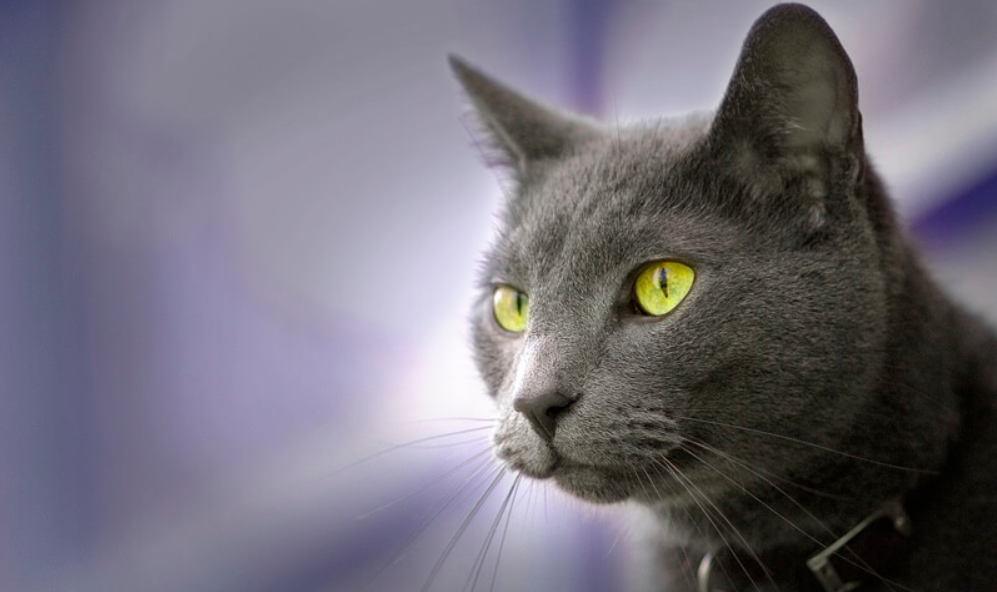The Russian Blue Cat, often referred to as the Russian Blue is a cat breed characterized by colors ranging from a light, glistening silver to a rich, slate grey. The breed has maintained its distinctive short, dense coat, which elegantly stands apart from the body, for over a century.
Russian Blue Cat Breed Overview || Russian blue cat size
| HEIGHT | 9–11 inches |
| WEIGHT | 7–12 pounds |
| LIFE SPAN | 15–20 years |
| GOOD WITH | Children, Seniors, Dogs, Cats, Families |
| TEMPERAMENT | Affectionate Neurotic Shy |
| INTELLIGENCE | High |
| SHEDDING AMOUNT | Infrequent |
| PLAYFULNESS | Medium |
| ACTIVITY LEVEL | Calm |
| VOCALNESS | Frequent |
| COAT LENGTH | Short |
| COLORS | Blue / Gray |
| PATTERNS | Solid |
History
After Russian Blue cats were introduced to Great Britain, the breed quickly captivated the cat enthusiast community. In 1875, Russian Blues made their debut at one of the world’s pioneering cat shows hosted at the Crystal Palace in London.
While not garnering any awards, one particular Russian Blue left a lasting impression, largely due to its remarkable beauty. Around 1912, coinciding with the breed’s presence in the U.S., Russian Blues received official recognition as a distinct breed.

Following World War II, Russian Blues faced a decline, but dedicated enthusiasts successfully preserved the bloodline. In Sweden, Finland, and Denmark, efforts were made to enhance the breed by crossing Russian Blues with Siamese cats, resulting in kittens with slightly longer and more angular features.
Meanwhile, in Great Britain, breeders opted for crossbreeding with Bluepoint Siamese and British Blues to develop thicker and more robust cats. Despite these variations, the Russian Blues we appreciate today still maintain a closer resemblance to their original parent breed.
Russian blue cat Characteristics
| Affection Level – High |
| Friendliness – Medium |
| Pet-Friendly – Medium |
| Exercise Needs – Medium |
| Kid-Friendly – Medium |
| Energy Level – Medium |
| Playfulness – Medium |
| Tendency to Vocalize – Low |
| Amount of Shedding – Low |
| Intelligence – High |
Russian Blue Cat Origin
The Russian Blue Cat is a naturally occurring breed, and its true origins remain shrouded in mystery. However, they likely originated in northwestern Russia. One theory suggests that these elegant felines are descendants of the esteemed pets of Russian Jar.
Regrettably, there is speculation that the initial Russian Blues may have lived in the wild, hunted for their prized pelts due to the allure of their thick, dense fur and distinctive coloring, fetching significant roubles.
Regardless, it is believed that Russian sailors developed a camaraderie with them around the 1860s and brought them aboard ships, particularly in the bustling port city of Arkhangelsk. This historical connection may explain how the breed found its way to Great Britain and Northern Europe. Notably, the translation of Arkhangelsk is “archangel,” which is why Russian Blue cats are sometimes referred to as archangel blues.
Temperament
Russian Blues are delightful and devoted feline companions who delight in following their owners and offering a warm welcome at the door. While initially alert and reserved, they transform into incredibly affectionate pets once acquainted with a new human.
In environments where they feel secure, Russian Blues reveal their playful and loving nature. They typically coexist well with children and other animals, including fellow cats and family dogs. Despite their affectionate disposition, these cats remain calm and are not excessively clingy.
However, their sensitivity may lead them to be reserved or uneasy around strangers. Although Russian Blues can be quite vocal, their meows are generally soft-spoken and serve as a gentle means of expressing their needs for food, water, or attention.
Known for their intelligence, independence, and high energy levels, Russian Blues exhibit playfulness, although they tend to mellow with age.
Personality
Russian Blue cats exhibit a curious yet composed demeanor, striking a balance between effect and independence without being overly clingy. Possessing a high level of intelligence, they may appear shy initially but transform into playful and loving companions once they feel at ease.

Although Russian Blue cats generally thrive in family settings and get along well with other pets, they tend to form a profound connection with a single individual. Once bonded, they exhibit a remarkable sensitivity to the emotions of their pet parent. If you’re feeling down, don’t be astonished if your Russian Blue reaches out to comfort you by gently patting your face!
Appearance
Russian Blues are medium-sized felines characterized by dense, short coats that give them a visually substantial presence. Their soft, silky fur displays a deep charcoal gray hue, accentuated with light, shimmering silver tips.
Due to their minimal shedding and low levels of the Fel d1 glycoprotein, known to trigger feline allergies, some consider Russian Blues to be “hypoallergenic.” Dr. Natalie L. Marks, DVM, CVJ, a veterinarian at Blum Animal Hospital in Chicago, notes, “These cats produce very low levels of glycoprotein Fel d1, which is a protein in cats that causes allergies in people.”
While no cat can be truly hypoallergenic, certain breeds, such as the Russian Blue, might be more suitable for individuals with allergies. Prospective owners are advised to spend time with the breed before bringing home a Russian Blue kitten to assess their reaction.
A distinctive feature of the Russian Blue’s appearance lies in its eyes, which undergo a captivating transformation from yellow to green as they mature. Born with blue eyes, these kittens transition to pale yellow or golden eyes, followed by yellow eyes with a green ring at around four months old, and eventually settle into a bright green hue in adulthood. Typically weighing between 7 to 12 pounds, these cats stand at an average height of about 10 inches.
Growth and maturity
Russian Blues typically enjoy a life expectancy ranging from 10 to 20 years, with some individuals surpassing the age of 25. These cats generally experience few health issues, as they exhibit minimal genetic problems and are not predisposed to diseases.
Being of small to medium size, Russian Blues typically weigh between 3.6 to 6.8 kg (8 to 15 lb) once fully grown, with males usually being larger than females. Their gestation period lasts approximately 64 days.
About Health
Russian Blues typically have a lifespan of 15-20 years and are generally robust due to being a naturally occurring breed.
According to Marks, “This breed is fond of eating and may grapple with obesity.” She mentions that they could be susceptible to progressive retinal atrophy (PRA), characterized by the degenerative deterioration of the retina or the eye’s vision center. Additionally, there is a potential risk of polycystic kidney disease (PKD), causing the kidneys to fill with fluid, and creating spaces that impede their normal function.
Responsible Russian Blue breeders typically conduct health screenings on kittens, but ongoing veterinary check-ups are crucial into adulthood. Regular visits to the veterinarian are essential to monitor the health of your Russian Blue, and seeking professional advice is recommended for their overall well-being.
Common Health Issues
Being a naturally occurring breed, Russian Blue cats generally enjoy good health. While there is a slightly heightened risk of bladder stones and urinary tract issues, the primary concern is obesity. Russian Blues have a penchant for eating, often expressing an eagerness for more.
If you have a Russian Blue cat, it’s advisable to measure their food portions and consult with your veterinarian to establish an appropriate nutrition plan. To address various health conditions, including those related to diet, the ASPCA pet health insurance plan offers coverage for diagnosis and treatment costs. Whether you already have a Russian Blue or are contemplating adoption, considering insurance coverage for your furry family member is a wise decision. Explore more by obtaining a quote now.
Allergies
Anecdotal evidence implies that individuals with mild to moderate allergies might tolerate Russian Blues better. Speculation surrounds the breed’s potential to produce low levels of glycoprotein Fel d1, a common source of cat allergies. Thicker coats near the cat’s skin are often associated with increased allergies.
While glycoproteins contribute to cat allergies, it’s important to note that having a Russian Blue does not eliminate all allergic reactions. Allergies may still occur, but they are generally less severe and of shorter duration compared to other cat breeds. Consequently, Russian Blues are widely favored among individuals with allergies globally.
Diet and Nutrition
It is advisable to consult with your veterinarian to determine the optimal food for your Russian Blue. Given the breed’s fondness for eating, it’s crucial to consider whether the cat is nursing.
Maintaining a lean physique for your Russian Blue is a key preventive measure against weight-related health issues like diabetes, heart disease, and arthritis.
Ensure you provide measured amounts of cat food two to three times a day at regular intervals. While skipping meals may seem convenient, it can encourage frequent snacking and contribute to weight gain. Always make fresh water available around the clock for your Russian Blue.
Care
Russian Blue cats have minimal grooming needs, making them low-maintenance. Occasional baths are sufficient, and weekly brushing helps remove loose hair, minimizing shedding. Regular activities like nail trimming, as well as cleaning their eyes and ears, are essential to ensure their overall well-being.

These pets don’t demand specific exercise routines; like most cats, they naturally expend energy through play and running around the house. Providing toys for your Russian Blue to engage with can further enhance their activity levels.
“The Russian Blue possesses a strong innate hunting drive, making toys like feather or fishing pole toys ideal for promoting both physical and mental exercise,” suggests Marks.
Known for their intelligence, Russian Blues are receptive to training. Teaching them to use the litter box and scratching post is generally straightforward, with praise and petting being effective training tools.
“This breed is quite vocal, enjoys interacting with household members or pet parents, but truly thrives on routine and is not very adaptable to change,” notes Marks. “Maintain scheduled meal times and play sessions.”
To prevent obesity, a common vulnerability in the breed, feed your Russian Blue high-quality cat food, carefully monitoring food intake. Consult your veterinarian to determine the appropriate amount and frequency for feeding your cat.
Living With
Russian Blue cats are highly intelligent, requiring both physical and mental stimulation, so it’s crucial to provide them with access to toys consistently. Given their strong hunting instinct, a finned fishing pole toy is an ideal game.
However, it’s advisable to keep these toys in a cat-proof location because your kitty might dismantle them, and there’s a risk she could ingest feathers or string, which can be harmful to her digestive system and overall health.
Maintaining a good hygiene routine ensures that your Russian Blue requires minimal grooming and health care. Essential items include a toothbrush and cat-safe toothpaste for keeping teeth clean and white, as well as a medium-toothed comb to maintain the sleek and luxurious quality of the double coat.
Russian Blue kittens particularly enjoy mealtimes, so it’s important to prevent overeating. While your cat may request food multiple times a day, sticking to a regular feeding schedule with measured amounts of cat food and limiting treats is recommended.
Similar to its Siamese counterpart, the Russian Blue is vocal and uses its voice to communicate needs for play, food, or rest. Being both attentive and persistent, the cat ensures that its requirements are met. However, they don’t adapt well to changes, such as different meal times or unfamiliar visitors, and will express their opinions. Regular interaction fosters a positive response, making the presence of a Russian Blue companion a constant source of companionship.
Adopt or Buy a Russian Blue Cat || Russian blue cat adoption
If you have an interest in the Russian Blue cat and desire more information, consider exploring the Cat Fanciers Association’s directory of Russian Blue Breeders in your vicinity. This allows you the opportunity to pose additional questions and personally meet Russian Blues.
Another avenue to explore is attending a cat show in your local area. Cat shows offer an enjoyable experience and provide an excellent opportunity to gain insights into various cat breeds from knowledgeable breeders and owners.
Should you be looking to acquire a purebred Russian Blue cat through a breeder in your region, this can be a viable option. However, if your preference is to adopt from a rescue facility, consider exploring these organizations:
Overview
These exquisite cats embody a gentle and sweet demeanor. While Russian Blues may initially be reserved with strangers, they wholeheartedly adore their owners. If you seek a feline companion that greets you at the door, accompanies you throughout the house, and cozies up on the couch beside you, the Russian Blue perfectly fulfills these expectations.
Furthermore, they rank among the most stunning cats within pure breeds, boasting captivating bright bluish-gray coats and mesmerizing emerald-colored eyes.
| Pros: 1. Often tolerated by people with cat allergies 2. Gentle and kind 3. Generally healthy and long-lived | Cons: 1. Can be shy and reclusive around strangers or commotion 2. Not as cuddly as some cats 3. Can become obese if overfed |
More Cat Breed And Further Research
Russian Blue Fun Facts
- Russian Blue cats possess subtly inverted mouths, resembling a faint smile reminiscent of the famous Mona Lisa smile.
- According to folklore, Russian Blues were traditionally placed in the chambers of newborn babies to ward off evil spirits.
- In the Warner Bros. hit film “Cats and Dogs,” a Russian Blue Cat is showcased as a trained assassin.
- The distinct bluish color of Russian Blues is attributed to a dilute gene. Surprisingly, the gene responsible for their bluish-brown hue is a variant of the black-haired gene.
- The internet sensation Nyan Cat, an animated meme featuring a half-cat, half-pop-tart, is inspired by the Russian Blue cat named Marty, illustrated by a Russian Blue enthusiast.
- In the popular Tom and Jerry cartoon, some fans speculate that Tom, characterized by his bright green eyes and bluish-gray complexion, might be a representation of a Russian Blue.
- Certain Russian Blues are born with “ghost stripes,” faded tabby markings that gradually disappear as the kittens mature.
Russian Blue Cat Breed Review
Russian Blue Cat FAQs
Are Russian Blues Affectionate?
Russian Blues display a high level of affection towards their loved ones but can exhibit wariness and aloofness around strangers.
What is the Cost of a Russian Blue Cat?
Typically, a purebred Russian Blue cat is priced between $400 and $600.
Do Russian Blue Cats Shed Excessively?
Russian Blue cats shed less compared to many other cat breeds, making them generally well-tolerated by individuals with cat allergies.
Most Related Searches
| Russian blue | Blue Russian |
| Russian blue kittens | Russian blue kitten |
| Blue cats | blue cat |
| Patronus quiz | Patronus quiz Pottermore |












5 thoughts on “Russian Blue Cat – All Special Information For Cat Lover…”